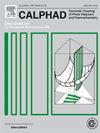镍-钼-镍三元体系的实验研究和热力学描述
IF 1.9
3区 材料科学
Q4 CHEMISTRY, PHYSICAL
Calphad-computer Coupling of Phase Diagrams and Thermochemistry
Pub Date : 2024-09-30
DOI:10.1016/j.calphad.2024.102739
引用次数: 0
摘要
镍基超级合金广泛应用于航空航天发动机、船用燃气轮机和其他工作条件恶劣的环境中。利用扫描电子显微镜 (SEM)、能量色散光谱 (EDS) 和 X 射线衍射 (XRD),在 800 °C 和 1000 °C 的整个成分范围内对 Ni-Mo-Y 三元体系的相关系进行了实验研究。在 800 °C 时确认了 13 个三相区域,在 1000 °C 时观察到 11 个三相区域。在这些温度下均未观察到三元化合物。此外,实验结果表明,钼(Mo)几乎不溶于镍-钇二元体系中的二元化合物。此外,还研究了典型合金的初级凝固相和凝固过程,发现了三种不同的初级凝固相。根据实验结果,通过 CALPHAD 技术对 Ni-Mo-Y 体系进行了热力学计算。实验结果与计算结果吻合良好,从而获得了一套自洽的 Ni-Mo-Y 三元体系热力学参数。本文章由计算机程序翻译,如有差异,请以英文原文为准。
Experimental investigation and thermodynamic description of the Ni-Mo-Y ternary system
Nickel-based superalloys are extensively utilized in aerospace engines, marine gas turbines, and other environments with severe operating conditions. The phase relations of the Ni-Mo-Y ternary system were experimentally studied across the entire composition range at 800 °C and 1000 °C using scanning electron microscopy (SEM) coupled with energy dispersive spectroscopy (EDS) and X-ray diffraction (XRD). Thirteen three-phase regions were confirmed at 800 °C, and eleven three-phase regions were observed at 1000 °C. No ternary compound was observed at these temperatures. In addition, the experimental results indicate that molybdenum (Mo) has almost no solubility in the binary compounds found in the Ni-Y binary system. Furthermore, the primary solidification phases and the solidification process of typical alloys were investigated, and three different primary solidification phases were found. Based on the experimental results, thermodynamic calculations for the Ni-Mo-Y system were performed through the CALPHAD technique. The experimental results agree well with the calculated, a set of self-consistent thermodynamic parameters for the Ni-Mo-Y ternary system was obtained in the present work.
求助全文
通过发布文献求助,成功后即可免费获取论文全文。
去求助
来源期刊
CiteScore
4.00
自引率
16.70%
发文量
94
审稿时长
2.5 months
期刊介绍:
The design of industrial processes requires reliable thermodynamic data. CALPHAD (Computer Coupling of Phase Diagrams and Thermochemistry) aims to promote computational thermodynamics through development of models to represent thermodynamic properties for various phases which permit prediction of properties of multicomponent systems from those of binary and ternary subsystems, critical assessment of data and their incorporation into self-consistent databases, development of software to optimize and derive thermodynamic parameters and the development and use of databanks for calculations to improve understanding of various industrial and technological processes. This work is disseminated through the CALPHAD journal and its annual conference.

 求助内容:
求助内容: 应助结果提醒方式:
应助结果提醒方式:


